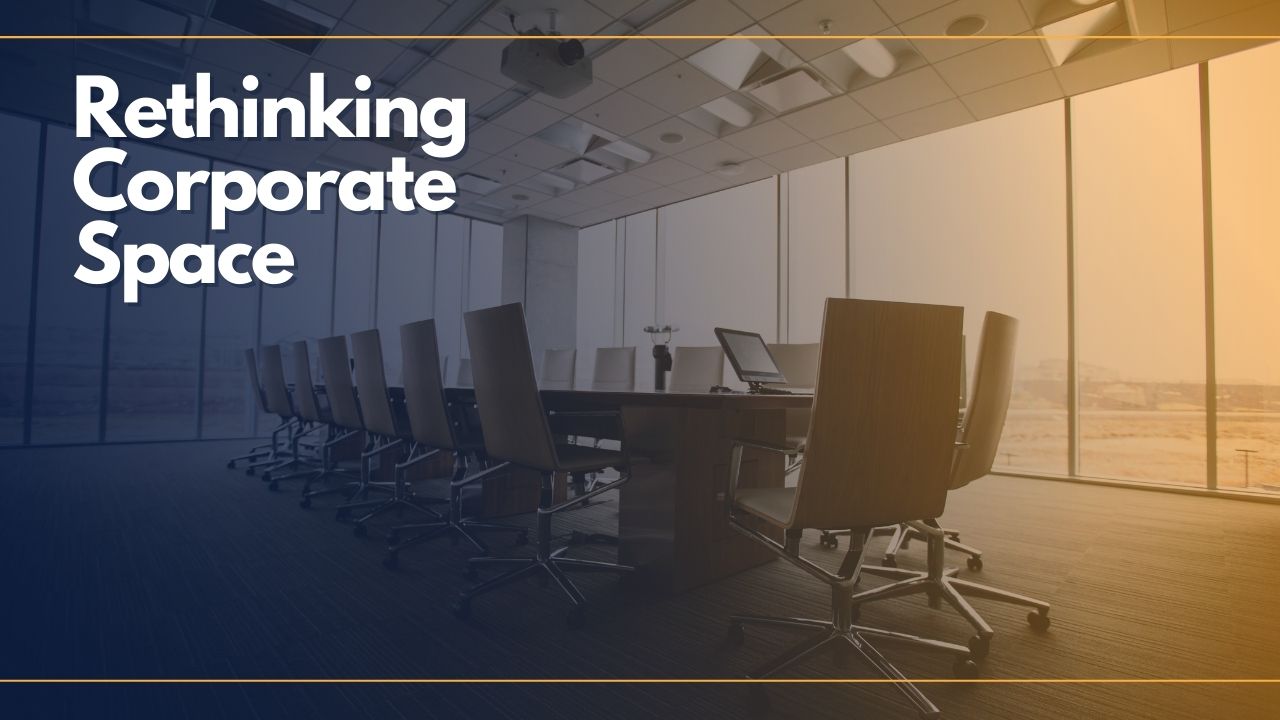- The pandemic is accelerating existing future of work trends, e.g. decentralisation.
- The demand for flexible space is set to skyrocket, especially in the suburbs.
- Virtual offices and flexible workspaces will be an integral part of the future of work.
Increasingly, business owners are replacing their full-capacity office commitments with flexible arrangements. Downsizing, hybrid working and decentralisation are just a few of the buzzwords we hear bandied about in the future of work conversation.
But this is nothing new.
Commercial spaces have been in a state of flux for some time now, with buildings that have run on the traditional lease model for decades switching to the more favourable serviced office (now, more commonly known as ‘flexible workspace’) model.
In uncertain times, businesses crave flexibility, and the coronavirus pandemic has acted as a catalyst for these changes.
We can’t predict what will happen in the long-term (perhaps we’ll be outsourcing work to robots on the moon), but we can confidently make some assertions about the future of work in the short to medium-term.
Read on to find out what’s in store.
- The trend away from cities and commercial buildings
- How trends are impacting the workplace
- The rise of virtual offices and flexible workplaces
The trend away from cities and commercial buildings
The pandemic is accelerating existing trends. Most notably, remote working, the trend away from cities, decentralisation and the decline of retail space.
1. Remote working

True, the pandemic has posed some new challenges for the corporate space sector, but many of the changes took root a long time ago.
Working from home is one such example, explains Jeff Engelstad, a professor of the practice with Franklin L. Burns School of Real Estate and Construction Management at the Daniels College of Business.
Companies were already trialling remote work practices in the early 2000s, at a time when offices in the suburbs were doing well and internet connections were becoming faster and more reliable.
Then COVID-19 hit and employers had no choice but to adapt by adopting remote working, without the advantage of a phased approach.
“We were all forced into a grand experiment of working from home, and we survived and thrived,” Englestad said.
This success is set to change the landscape of work forever.
“We’re not just going to flip the switch and we all go back,” Engelstad said. “Offices are going to have a very long-term structural change.”
2. Moving away from cities

Some argue that before the pandemic, cities in the US were experiencing a revival. Some say that this began in the late ‘90s or early ‘00s when suburbia started to fall out of favour with the people who grew up in it. Cities began to draw in a new generation.
“Pundits welcomed the arrival of the creative class, and promised an extended era of urban fortune assured by the commitment to city life by the millennial generation,” writes Alex Krieger, Principal, NBBJ. Professor of Urban Design, Harvard University, in an article for the Harvard University Graduate School of Design.
“Even some empty nesters were happy to part with lawn mowers in exchange for more convivial urban contexts.”
The tables, however, are turning.
He predicts that cities like New York City, Chicago, San Francisco, Los Angeles will continue to lose population.
“Now in 2020, many people are again falling prey to anxieties about cascading urban problems. We have been reminded that density aids in the spreading of disease.”
This isn’t just happening in the US, and, as Krieger notes, there are lots of other underlying driving factors aside from the pandemic. Take the cost of living, for example.
Rental prices are on the increase and purchasing a home is well out of reach for many middle-income households, especially in cities where prices tend to be higher.
People are looking beyond large metropolises to smaller cities and towns that can facilitate a “better” lifestyle at a lower living cost.
Examples of growth cities in the US include:
- Austin
- Texas
- Raleigh
- North Carolina
- Nashville
- Tennessee
- Salt Lake City
- Utah
- Charlotte
- North Carolina.
3. Decentralisation

Global demand for flexible workspace has been on a steep upward trajectory for at least seven years now. According to 2018 research by Instant Offices, global demand rose by 50% and there was more supply of flexible space than ever before.
In the same year, Instant estimated the global market to comprise 32,000+ centres (representing 521 sq ft), an increase of 15% YoY since 2013.
Unfortunately, as with many other industries, some flexible workspace operations had to close for good during the pandemic due to lack of funds or even bankruptcy.
Lots pulled through though, and the demand for flexible space is set to skyrocket – especially in secondary cities. For many businesses, the corporate office is taking on a different form.
What is a corporate office?
A corporate office, otherwise known as a corporate headquarters or head office, is the location where important business decisions are made and where the majority of a business’ employees work.
Until recently, most big businesses based their HQ in a city centre.
However, during (and even before) the pandemic, many of these “important business decisions” and functions were beginning to take place in the virtual realm, rendering the physical realisation of the head office unnecessary.
And this is where decentralisation comes in.
A growing number of companies are adopting the hub-and-spoke approach, where regional spokes allow for a more distributed workforce (as opposed to trying to fit everyone into a central HQ).
The benefits are numerous:
- Office rent is often cheaper per sq. ft. outside of large metropolitan areas.
- There’s generally more indoor and outdoor space, making social distancing easier.
- Decentralisation drives innovation within the company because it opens up access to talent from different areas, as opposed to hiring from the same “cohort” time and again.
- A reduced commute means employees can embrace active modes of travel, making for a healthier and more environmentally-friendly workforce.
Decentralisation and flexible working practices often make for a happier workforce too.
Researchers at the University of Manchester found that “employees who have been allowed to work flexibly tend to demonstrate greater commitment and a willingness to ‘give back’ to the organisation.”
4. The decline of retail spaces

Retail has undoubtedly been a hard-hit part of the CRE sector during the pandemic. In many areas, bricks and mortar retail is facing a decline as e-commerce takes over.
But as with the other future of work trends in this article, the shift was already happening before the pandemic.
Debenhams, an iconic UK brand, is a prime example.
The last remaining Debenhams stores shut up shop in May 2021, more than 240 years after the business began trading.
At one point there were over 150 Debenhams stores across the UK. However, the retail firm went into administration in 2019 after sales fell YoY.
The online fashion retailer, Boohoo, bought the Debenhams brand, enabling it to continue trading online.
According to McKinsey, e-commerce witnessed ten years of growth within the first three months of COVID-related restrictions last year.
So what’s going to happen to these newly shuttered spaces?
It’s thought that some will be taken over by other retailers.
Others could be repurposed. In some instances local councils or the government may have to intervene to prevent them from sitting empty and derelict.
Others could be turned into residential apartments.
Empty highstreets could also be completely reimagined, with some people arguing that underutilised shopping centres should be knocked down and replaced with green space.
In the UK and elsewhere, empty retail units on the high street could be repurposed into – you guessed it – new flexible workspaces.
Changes to planning laws and the appetite for working closer to home could see this emerging trend become commonplace in the near future.
How trends are impacting the workplace
We’ve established that we’re not going to go back to how we worked before the pandemic. This doesn’t apply to all industries, of course, but the majority of employees enjoy the personal and financial benefits that come with being able to work from home.
Here’s how companies are adapting.
The adoption of the 30% (hybrid) approach
In March 2021 Industrious published The 30% Rule: Planning Your Team’s Return to the Office. The guide looks at the future of work from home and provides tips for organisations looking to embrace hybrid working.
It describes the future office as being “a magnet of social activity, connection, and collaboration”, and shares what it calls the 30% rule.
It suggests the following approaches:
- Survey team members every 30 days to evaluate performance
- Bucket employees into two groups: 30% in-office / 70% remote work, or 30% remote / 70% in-office
- Modify up to 30% of existing office space to better suit the team’s current needs
- Resume in-office operations when 30% of staff is vaccinated.
Working from different environments (e.g. the office and home) is called hybrid working.
Industrious says that to figure out who should be remote and who should work in the office more, companies can split employees into the following working styles:
- Collaborators
- Connectors
- Residents
- Nomads.
The guide also goes on to say that although some businesses might be tempted to scale back their office footprint to facilitate hybrid work, it’s not necessarily the best idea.
Instead, it suggests “reimaging” and “redistributing” office space.
The fact is, a lot of offices were initially designed to support individual work, whereas the office of the future will have to facilitate collaboration.
Employers should bear this in mind when redesigning their workspace. Industrious recommends incorporating up to a 30% redistribution from individual to shared, collaborative settings that support social and professional interaction.
To compete for tenants (occupiers or members) landlords and flexible workspace operators will also have to differentiate themselves.
Moving forward, the focus will be on additional – and sustainable – services and facilities that boost productivity and wellbeing.
The best offices will be those with a purpose.
Offices in the suburbs
Some organisations are turning away from the big city and looking to the suburbs for workspace. Working in the suburbs can be more convenient for employees and affordable for employers.
Especially flexible workspaces, where members only pay for the space they need.
Demand for suburban workspace in the UK has skyrocketed since the COVID-19 pandemic emerged, as businesses figure out ways to cater to tomorrow’s workforce.
Research published by IWG in March 2021 revealed a 32% increase in demand for suburban office space in the first quarter of 2021 compared to 2020.
On the other hand, enquiries for city centre offices fell by 10%. IWG also found that enquiries for rural workspaces rose by 20%.
“The past 12 months has shown that while businesses can largely operate effectively remotely, they are planning for a hybrid future, companies are moving rapidly towards a hub and spoke model maintaining a central headquarters, but also empowering staff to access smaller co-working spaces, closer to their home and often accessible by foot or by bike.”
Mark Dixon, founder and chief executive of IWG
The rise of virtual offices and flexible workplaces
The future of work is being shaped by two services: virtual offices and flexible workspaces.
Virtual offices
Virtual offices have been a vital part of the transition to hybrid work. They allow businesses to continue operating without the need for a physical office space.
But what is a virtual office, exactly?
Broadly speaking, a virtual office is a flexible type of office membership that provides business owners with the bare essentials for operating a business, including:
- A business address
- A business telephone number
- Mail handling, scanning and forwarding.
These are the basics. Some virtual office operators also provide:
- Discounted meeting room usage (at the address’ commercial building)
- The option to book hot desks
- Invitations to virtual and in-house events
- Access to a network of like-minded entrepreneurs.
Some businesses start out with a virtual office membership and then move into a flexible workspace when they start to hire.
Fully-remote companies that don’t require a physical space may choose to keep their virtual membership indefinitely.
A virtual office can also help bolster a business’ reputation.
Let’s face it: depending on your industry, having your home address and personal number on your business card won’t cut it with some potential clients.
It can also wreak havoc with your work-life balance.
Flexible workspaces

Flexible workspaces will continue to proliferate as traditional offices carry on experiencing losses. Why? Because flexible workspace memberships allow workers to access offices wherever they happen to live.
It used to be that flexible workspaces were the domain of freelancers and small startups.
That’s not the case anymore.
Some of the world’s largest brands have flexible workspace on their property portfolio, including IBM, whose CIO Office, the arm that develops and manages IBM’s Business Partner applications and focuses on productivity, is based in a WeWork.
Currently, flexible workspace can be broken down into three categories:
Coworking
Hot desks or dedicated desks in an open plan workspace area. You’re generally seated on a row with other members and share the following facilities:
- Kitchen
- Meeting rooms
- WCs
- Breakout space
- Phone booths/pods
Serviced offices
Private offices in a “serviced” building. Much like coworking, you get your own space to work in but share amenities with other members.
Some serviced offices and coworking spaces are pretty basic, and have a price tag to match. Others go the extra mile to provide members with access to business support, yoga and gym facilities, great coffee – you get the idea.
Managed offices
Managed offices are like serviced offices but for bigger companies that want a bit more autonomy. You get a large office (or entire floor) that you can brand and furnish in line with your preferences. And probably access to your own meeting room.
Cleaning, internet, phone lines and reception support tend to be included in the price.
Managed offices are more flexible than traditional commercial leases. The latter are often tricky to get out of, require lots of legal work behind the scenes and involve capital expenditure for fit-outs, refurbishments, dilapidations, etc.
What will offices of the future look like?

We don’t have a crystal ball, but we can certainly say what offices will look like in the short-term. Office design is being driven by the need to:
- Accommodate different work styles
- Adapt to changing circumstances
- Track space utilisation to work smarter
- Cultivate a sense of community
- Provide support around mental health and wellbeing.
Let’s take a closer look at what we can expect to see.
Pods and pop up booths
Open plan workspaces are great for enabling collaborative work.
Some people can even work quite contentedly in them when doing focused work, and are able to block out the ambient noise and distractions. (Others invest in noise cancelling headphones.)
In the future though, office operators will have to accommodate those who prefer a private space to concentrate in, as well as areas for people to go to take Zoom calls.
Free-standing privacy booths and adaptable pods offer the perfect solution. They often include a desk, soundproofing, power outlets, light, ventilation and a superfast internet connection.
Sensors and data tracking
Organisations are already using data tracking applications and sensors to get analytics on how workers utilise the office.
This information enables them to make improvements in real-time; improvements that make the workspace more energy-efficient.
It means that companies can adapt the space for the people who are using it at any given time, making for a happier, more productive workforce.
Community-centric spaces
Some of the most successful flexible workspace operators run on a membership model that prioritises community as well as physical space.
Members of these workspaces can attend networking events, socials, seminars, workshops, industry talks – both online and offline.
From this moment forward we’re more likely to go to the office to collaborate and meet people, and conduct more focused, individual work at home.
Wellness at the fore
Health and wellness are set to play a pivotal role in the future of work after Covid.
Deloitte’s 2020 Global Human Capital Trends Report found that 79% of businesses saw a surge in employee requests for greater mental health support as a result of COVID-19.
Meanwhile, according to the Society for Human Resources Management, healthcare coverage is the top benefit that employees want.
The wellness trend was influencing office design even before the pandemic.
For instance, ROOM, a company that makes soundproof privacy booths, collaborated with the meditation app Calm in 2019 to create a meditation booth for office use.
And to make workspaces more inclusive, office operators and employers must also ensure that buildings are accessible and include spaces that, for example, working mums can go to pump breast milk.
The future of work is flexible
While commercial office spaces aren’t going to become obsolete any time soon, they are in the process of being replaced with more flexible alternatives and are unlikely to return to their former importance.
Virtual offices and flexible workspaces will be an integral part of the future of work in 2021 and beyond. These relatively new types of workspaces will fill the holes in the commercial real estate and workplace market left by the decline of corporate spaces.
Are you ready for the future of office work?
If you’re not planning on going fully remote but don’t want to commit to a traditional commercial space, a virtual office or flexible workspace could be just what you’re looking for.
Scale up or downsize
It’s much easier to scale up in a flexible workspace than it is in a traditional commercial office. For example, you can start off with a 5-person office in the building and, depending on availability, could upsize to a 10-person office when your business grows.
The same goes for downsizing
Let’s say you have 10 employees. You sign up for a 6-month office in a flexible workspace, however after a few months you decide to operate a hybrid work model. No problem – you just need to give your operator notice.
Minimal commitment
Commercial spaces often require the tenant to sign up for a period of three years or more. Flexible workspaces are a lot more flexible. In fact, some operators allow you to rent an office in their building on a monthly rolling basis.
Notice periods are often shorter too, so you can move out asap without having to pay a hefty fee to do so. In times of uncertainty, this level of flexibility is invaluable for businesses.
Attract and retain talent
Attracting and retaining talent is one of the biggest challenges business owners face. Providing your team with access to the services and amenities of a flexible workspace won’t fix all your HR hurdles, but having the following on your doorstep can definitely help:
- A comfortable, spacious work environment
- Quality kitchen space, with snacks and drinks
- Quiet breakout areas for relaxation
- The option to socialise with other businesses.
Network and collaborate
Ultimately, flexible workspaces are ripe environments for collaboration and networking because they’re occupied by multiple businesses. Often, operators will run social events so that occupiers can mix and get to know each other.
So, if you’re looking to be an active participant in future of work trends, why not book a viewing at a local flexible workspace today?
You can use AllWork’s search platform to find a flexible workspace. If you’re interested in a virtual office membership, head over to Alliance Virtual Offices.
Frequently Asked Questions (FAQs)
- What are work spaces?
Workspaces are environments that are set up for office-based work. Traditional commercial workspaces used to be the most popular type, but now flexible workspaces – including coworking spaces – are fast becoming the workspace of choice.
- What are the spaces found in an office building?
Types of spaces found in modern office buildings include: private offices; coworking spaces; breakout areas; meeting and conference rooms; kitchens; WCs; event zones; and outdoor areas such as roof terraces.
- How important is office space?
Office space can play a significant role in employee engagement and productivity. Some people are unable to work properly in their home environment, which is why it’s a good idea to give employees the option to work in an office, at least part-time.
- Are offices going away?
Offices are not going away. However, the way we use them and how they operate is changing. Moving forward, offices will be more agile, enabling businesses to sign up, scale up, downsize or leave with relative ease.
- Where are the most corporate headquarters?
According to WorldAtlas, Tokyo has the most company headquarters (613) followed by New York (217) then London (193).


 Dr. Gleb Tsipursky – The Office Whisperer
Dr. Gleb Tsipursky – The Office Whisperer Nirit Cohen – WorkFutures
Nirit Cohen – WorkFutures Angela Howard – Culture Expert
Angela Howard – Culture Expert Drew Jones – Design & Innovation
Drew Jones – Design & Innovation Jonathan Price – CRE & Flex Expert
Jonathan Price – CRE & Flex Expert














